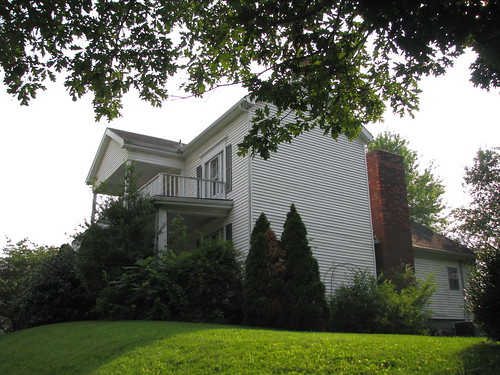 |
| Judge John E. Cooper House – West Liberty, Ky. |
On Main Street, at the northern edge of Morgan County’s seat, stands the Judge John E. Cooper House – the oldest extant house in West Liberty. Built in 1872/73, this two-story frame structure assumes no formal architectural design, but is representative of much of eastern Kentucky’s mid-19th century architecture with one notable exception. The entire house was completed in one construction effort – this rapid build and the scale of the project would have made it a most-impressive structure for Morgan County in the 1870s. The National Register profile for the house makes careful note of this feat, pointing out that it would have been considered symbolic of Cooper’s power and prestige, without being showy.
Judge Cooper was a powerful figure in regional politics and law. In the Civil War, he and his fellow Morgan countians sympathized with the Confederacy and took up arms for her; he was wounded at the Battle of Ivy Monutain (Floyd County) in November 1861. He attended law school and graduated from the A&M College at Kentucky University before returning to Morgan County. There, he married and practiced law before becoming county attorney and, later, state senator. Col. John Thomas Hazelrigg spoke well of the senator during his centennial address in 1876, saying that Cooper was “full of hope and promise, now engaged in the practice of his profession as a lawyer, and is distinguished for his zeal and energy with which he represents the interests of his clients. Although young in years, he has taken a front rank in his profession and bids fair to enroll his name among the first jurists of the Commonwealth.”
Cooper did not disappoint Hazelrigg. In 1883, Cooper was nominated to fill a vacancy on the circuit court. He was repeatedly elected to the position and held the office for 22 years, “longer than any other man.” Of Judge Cooper, Judge Edward C. O’Rear (Ky. Ct. Appeals) wrote: “He was a vigorous executive and worked as hard on the bench for the whole term of his service as at any time whilst at the bar. He not only adjudged the law in his courts, he administered it. A rugged type, powerful physique, dignified bearing, he gave to each case before him the most painstaking investigation.” Judge O’Rear went on to note that Cooper never wore spectacles, “though he read every paper in every case submitted to him, and every authority cited, and prepared with his own pen the instructions to juries, his orders and judgments.”
It is believed that Cooper designed the house which he continued to own until 1896, though construction was completed by Thomas Jefferson Cassity and his son, Reuben. Cooper, however, was known to have done some architectural planning; the plan and specifications for the third Morgan County courthouse were drafted in 1870 by Morgan. Local legend, though improbable, suggests that Morgan modeled the courthouse after the colonial capitol at Williamsburg, Virginia.
Additional pictures of the Cooper House are available on flickr.
Bibliography
NRHP, “Judge John E. Cooper House“
NRHP, “Morgan County Courthouse”
